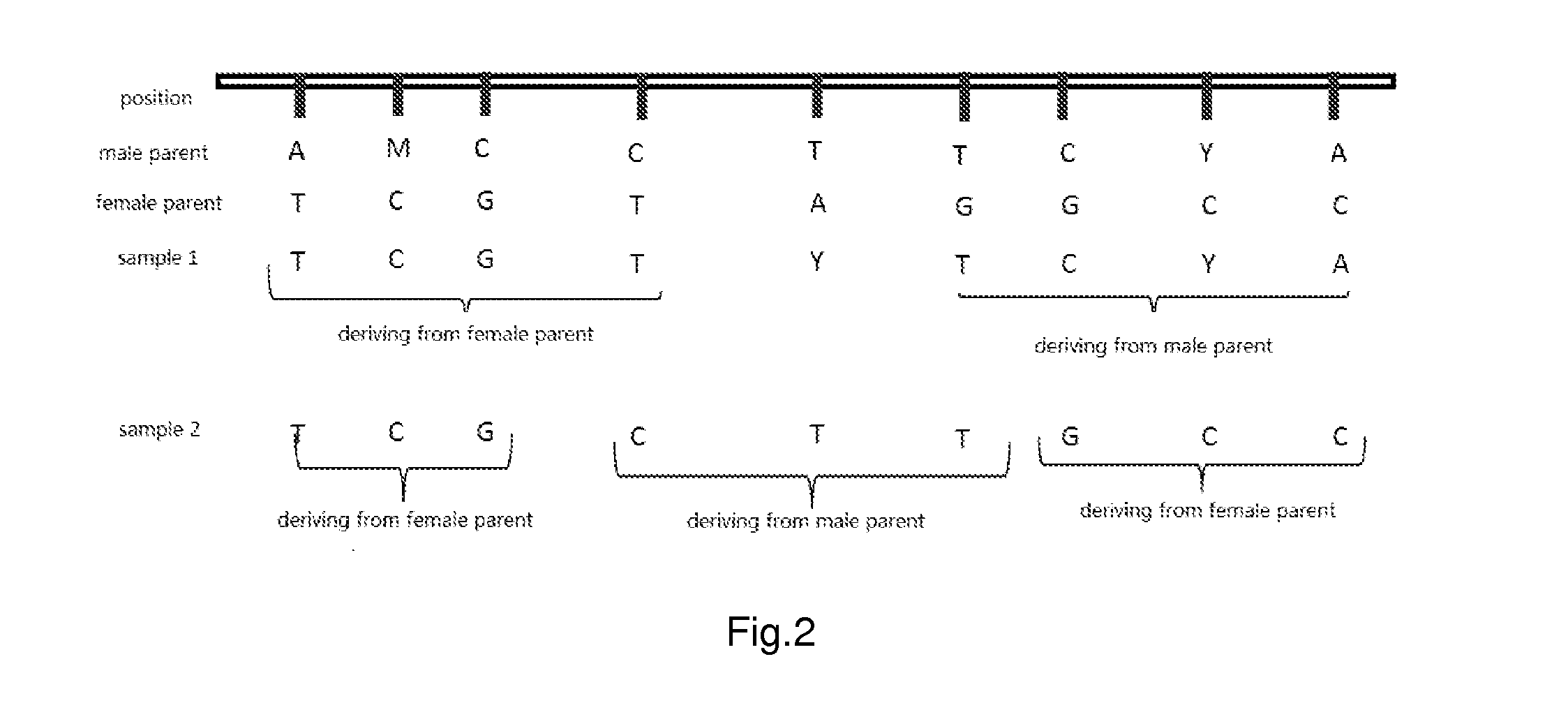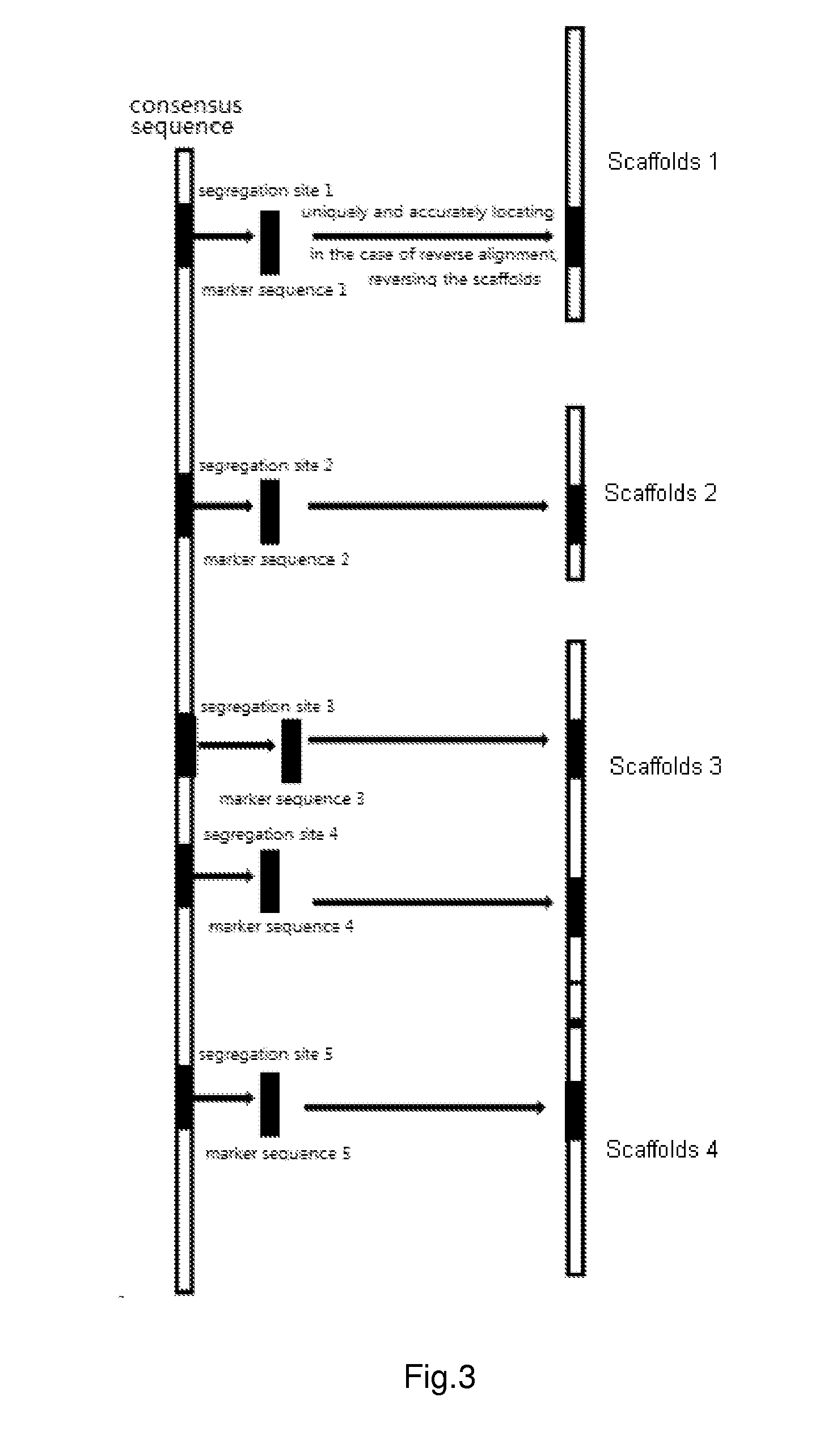Parental genome assembly method
a genome and assembly technology, applied in the field of genetics, genomic bioinformatics, gene engineering technology, etc., can solve the problems of difficult assembly of reads into genome sequences such as chromosome sequences simply relying on assembly software, and the limitation of connecting sequencing data, so as to improve the accuracy of assembly of genomes
- Summary
- Abstract
- Description
- Claims
- Application Information
AI Technical Summary
Benefits of technology
Problems solved by technology
Method used
Image
Examples
example 1
Generation of Inbred Lines Progeny Population of Rice
[0116]9311 rice (Yu, J. et al. A draft sequence of the rice genome (Oryza sativa L. ssp. indica). Science 296, 79 (2002)) was subjected to cross-fertilization with PA64 rice Wei, G. et al. A transcriptomic analysis of superhybrid rice LYP9 and its parents. Proc Natl Acad Sci USA 106, 7695-701 (2009)), to generate F1 generation. Then the F1 generation was subjected to self-fertilization for 16 generations, to obtain inbred lines progeny population of rice.
example 2
Generation of Reads of Parents and Inbred Lines Progeny Population
[0117]132 progeny individuals were selected from progeny population after 16 generations self-fertilization. According to specification of manufacturer, using Solexa sequencing platform (Illumina Company), the selected progeny individuals were subjected to individual genome sequencing having a sequencing depth of 2× (namely, the amount of sequencing data was twice as that of genome), so as to provide genome sequencing data of progeny individuals (reads). Using the same method, the genomes of parents (9311 rice and PA64 rice) were subjected to sequencing having a respective sequencing depth of 10× (namely, the amount of sequencing data was 10 folds as that of genome).
example 3
Generation of Scaffolds of Parents (9311 Rice and PA64 Rice)
[0118]Methods being well-known in the art were used to, such as SoapDenovo assembly software (http: / / soap.genomics.org.cn / soapdenovo.html), subject reads of 9311 rice and PA64 rice to connecting respectively, to obtain scaffolds of 9311 rice and PA64 rice respectively.
[0119]Besides, scaffolds of 9311 rice and PA64 rice which had been published could also be used. For example, in 2002, genomes of 9311 rice and PA64 rice had been subjected to sequencing having a sequencing depth of 6.02X using Sanger sequencing platform, and the obtained reads had been connected into scaffolds using RePS assembly software (http: / / genome.cshlp.org / content / 12 / 5 / 824.full) being well-known in the art, sequence information of these scaffolds could refer to Yu, Hu et al. 2002. These known scaffolds were used in following examples.
PUM
| Property | Measurement | Unit |
|---|---|---|
| Fraction | aaaaa | aaaaa |
| Length | aaaaa | aaaaa |
| Depth | aaaaa | aaaaa |
Abstract
Description
Claims
Application Information
 Login to View More
Login to View More - R&D
- Intellectual Property
- Life Sciences
- Materials
- Tech Scout
- Unparalleled Data Quality
- Higher Quality Content
- 60% Fewer Hallucinations
Browse by: Latest US Patents, China's latest patents, Technical Efficacy Thesaurus, Application Domain, Technology Topic, Popular Technical Reports.
© 2025 PatSnap. All rights reserved.Legal|Privacy policy|Modern Slavery Act Transparency Statement|Sitemap|About US| Contact US: help@patsnap.com



